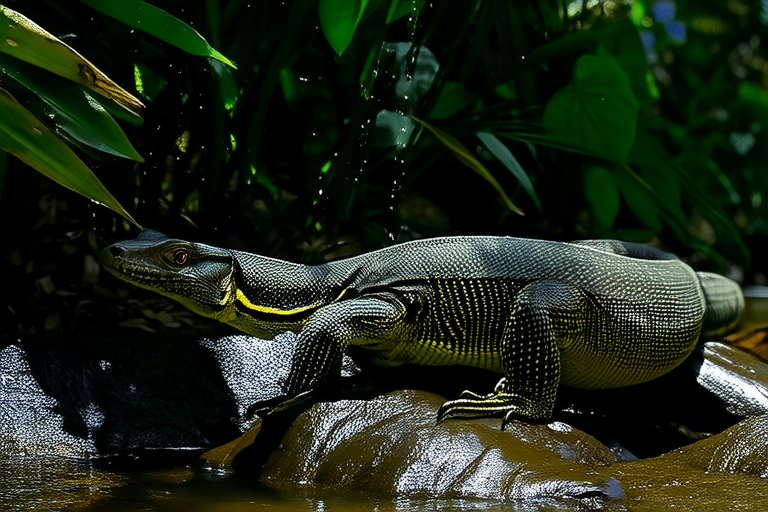Water Monitors Unleashed: Discover Their Unique Behaviors and Needs
Water monitors (Varanus salvator) are among the largest lizards in the world, known for their impressive size and adaptability. Native to Southeast Asia, they thrive in diverse environments ranging from coastal mangroves to freshwater rivers and lakes. These lizards have adapted to both aquatic and terrestrial life, making them fascinating subjects for reptile enthusiasts.
Physically, water monitors can grow up to 3 meters (9.8 feet) long, with males typically being larger than females. They possess strong, muscular tails that help them swim efficiently and defend themselves against predators. Their scales are rough and provide excellent camouflage in their natural habitat. Water monitors come in various shades, including brown, gray, and black, with some individuals exhibiting distinctive patterns or markings.
Unique Behaviors: Aquatic and Terrestrial Activities
Water monitors exhibit remarkable behaviors that reflect their dual nature. In the water, they are adept swimmers, using their powerful tails to propel themselves through the currents. They can stay submerged for extended periods, sometimes even hunting underwater. On land, they are agile climbers, capable of scaling trees and rocks with ease. Their sharp claws assist in gripping surfaces while they explore their environment.
These lizards are also quite curious and intelligent, often displaying playful behavior. They enjoy interacting with their surroundings, exploring new areas, and investigating objects within their reach. Social interactions among water monitors can vary; they may tolerate each other’s presence but are generally solitary creatures in the wild. Captive water monitors can become accustomed to human interaction, forming bonds with their owners over time.
Feeding habits of water monitors are varied and depend on their environment. In the wild, they are opportunistic feeders, consuming insects, small mammals, birds, fish, and even carrion. Their diet can be quite diverse, allowing them to adapt to different food sources depending on availability. In captivity, it is essential to replicate this diversity to ensure their nutritional needs are met.
Dietary Needs: Ensuring a Balanced Diet
Providing a balanced diet is crucial for the health and well-being of water monitors. A typical diet should include a variety of prey items such as mice, rats, chicks, fish, and insects. It is important to offer a mix of whole prey and lean meat to avoid obesity and maintain muscle mass. Additionally, supplementation with calcium and vitamins is necessary to prevent metabolic bone disease and ensure proper growth.
Variety in the diet is key. Offering different types of prey items not only satisfies the lizard’s nutritional requirements but also stimulates its appetite and keeps it mentally engaged. Feeding should be done regularly, with younger monitors requiring more frequent meals compared to adults. Overfeeding should be avoided to prevent health issues like obesity and related complications.
Housing Requirements: Creating the Ideal Environment
Proper housing is essential for the well-being of water monitors. The enclosure should be spacious enough to accommodate the lizard’s size and allow for both swimming and climbing. A minimum enclosure size of 6 feet by 4 feet by 4 feet is recommended for adult water monitors. Smaller enclosures can lead to stress and behavioral problems.
Temperature control is vital for maintaining optimal health. Water monitors require a basking area with temperatures between 90°F and 95°F (32°C to 35°C), and a cooler area around 75°F to 85°F (24°C to 29°C). Heat lamps, ceramic heaters, and under-tank heaters can be used to achieve the desired temperatures. Humidity levels should be maintained between 60% and 80% to mimic their natural habitat.
Lighting is another critical aspect of housing. UVB lighting is necessary for vitamin D3 synthesis, which aids in calcium absorption. Full-spectrum lighting should be provided for 10 to 12 hours per day. Substrate choices can range from coconut fiber to cypress mulch, depending on personal preference and the lizard’s comfort. Avoid substrates that could cause impaction if ingested.
Handling and Training: Safety First
Handling water monitors requires patience and caution. Younger lizards are more manageable, but even they can become defensive when threatened. Always approach the lizard slowly and calmly, allowing it to acclimate to your presence. Use gloves when handling to protect yourself from scratches and bites.
Training water monitors involves positive reinforcement techniques. Rewarding desired behaviors with treats can encourage interaction and trust. However, training should never be forced, as this can lead to stress and aggression. Regular handling sessions can help build a bond between you and your pet, but always prioritize the lizard’s comfort and safety.
Tips for New Owners: Care and Health Checks
New owners should familiarize themselves with the specific needs of water monitors. Regular care includes daily feeding, cleaning, and monitoring for any signs of illness. Health checks should be performed regularly, focusing on skin condition, eyes, and overall activity level. Any changes in behavior or appearance should prompt a visit to a veterinarian specializing in exotic animals.
Common misconceptions about keeping water monitors include the belief that they are easy to care for due to their hardiness. While they can survive in less-than-ideal conditions, providing proper care ensures a longer, healthier life. Another misconception is that they are docile pets. While some water monitors can become tame, they are still wild animals and may display aggressive behavior if provoked.
